The New Motorola Moto X (2nd Gen) Review
by Joshua Ho on September 17, 2014 9:00 AM EST- Posted in
- Smartphones
- Motorola
- Android
- Mobile
Display
Without question, the display is one of the most important aspects of a smartphone. Unlike desktops and laptops, smartphones are primarily interacted with through their displays. Unfortunately, it’s hard to evaluate a display by eye as human vision is strongly dependent upon context. In order to control for this aspect, we turn to SpectraCal’s CalMAN 5 with a custom workflow in order to test smartphone displays. At any rate, let’s get into the data.
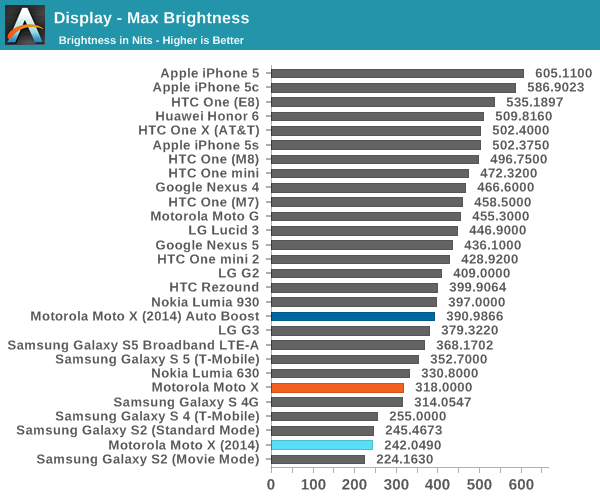
In the basics, the new Moto X is a bit on the low side. While AMOLED has traditionally struggled with luminance in situations such as the web browser and light-themed applications, Samsung’s Galaxy S5 and S5 LTE-A Broadband have shown that it’s possible to achieve levels of brightness approaching some of the brightest RGB-stripe LCDs. As the brightness of the Lumia 930 is about equal to the new Moto X, I suspect we're looking at the Galaxy S4/Note 3 generation of panels. This seems to be backed up by pictures of the subpixel layout seen below as the green subpixels seem to be noticeably larger when compared to the Galaxy S5's panel.
Contrast is still incredible, but I can still see the purple smearing effect that comes from unlit to lit pixels. I’m still unable to get a clear answer on why this is, but it’s likely that capacitance somewhere in the system is causing this issue in the form of RC delay. Whether this is a fixable issue is something I’m not aware of yet. The clear solution would be to set black to the lowest possible brightness a lit pixel can be, but this would make for worse contrast.

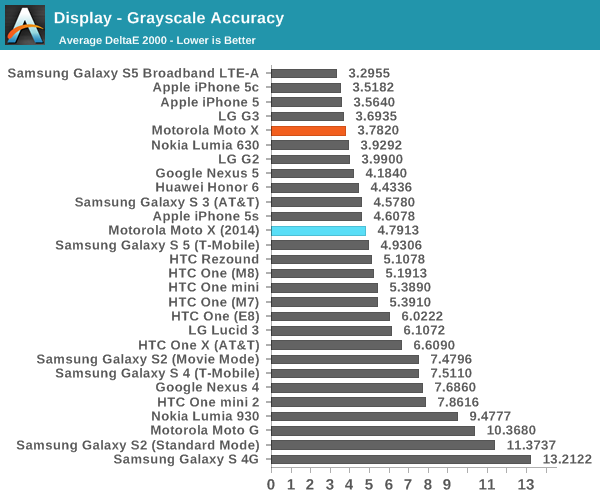
In grayscale, the new Moto X isn’t the best. We see that the display is just a bit too red, and that most of the luminance is coming from red and green. This makes sense from a power and display lifetime perspective though, as blue tends to have the least efficient emitter material in an AMOLED display. However, this translates to poor grayscale performance. The green tint tends to show itself in certain shades of grayscale as well.

In our saturation sweep, the new Moto X continues to be rather poor in its performance. While on Samsung phones it’s normal to see colors like this on the default display mode, there’s usually a mode that correctly constrains the display to sRGB which is the industry standard for displaying colors. There’s no such mode on the new Moto X, so the display significantly overshoots sRGB. This doesn’t bode well for the ColorChecker, which provides the most thorough look at color accuracy.
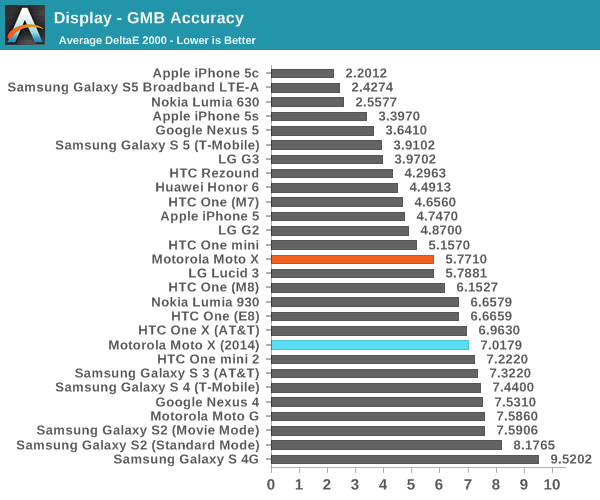
As predicted, the new Moto X does poorly in the ColorChecker. There’s really not much that the Moto X can accurately display in sRGB as just by pushing the gamut too far, even if there wasn’t saturation compression for some colors, the large gamut will cause distortion of all colors within the gamut triangle.
Unfortunately, it’s not clear where this lack of attention to color accuracy comes from. In discussions with Andrei it's clearly possible to calibrate the AMOLED panel from the GS4 quite accurately, and there's no real technical limitation for AMOLED to lack good calibration. However, judging by the relatively low peak brightness there are other issues as this could affect Motorola's performance in battery life tests. This seems to suggest that Motorola is unable to access the latest generation of AMOLED panels from Samsung Display.
This would be a rather startling thought, as it means that no matter what Motorola does to improve their implementation of Samsung’s AMOLED displays, they will always be behind the curve. If it becomes clear that Samsung’s AMOLED is the best display from a user-facing standpoint, every other OEM will face significant barriers in competition as they would be unable to access the latest generation AMOLED panels. The real solution here is for other display manufacturers such as LG, JDI, and AUO Optronics to catch up.
At any rate, the display of the new Moto X seems to be relatively poor compared to what we see in the Galaxy S5 LTE-A (and likely the Note 4), along with the iPhone 5s, Nexus 5, and One (M7). While it’s impossible to ignore the power advantage of AMOLED when implementing functions like Moto Display, the relatively low peak brightness and poor color accuracy are concerning.


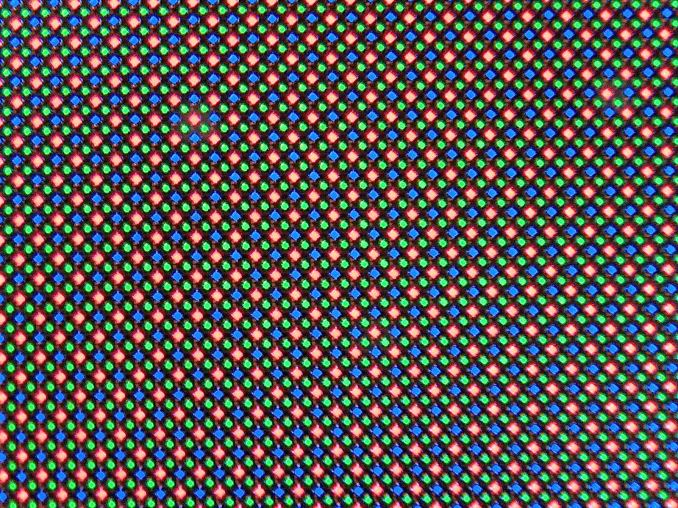

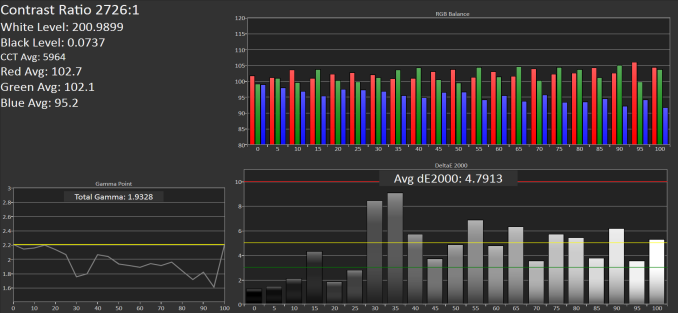

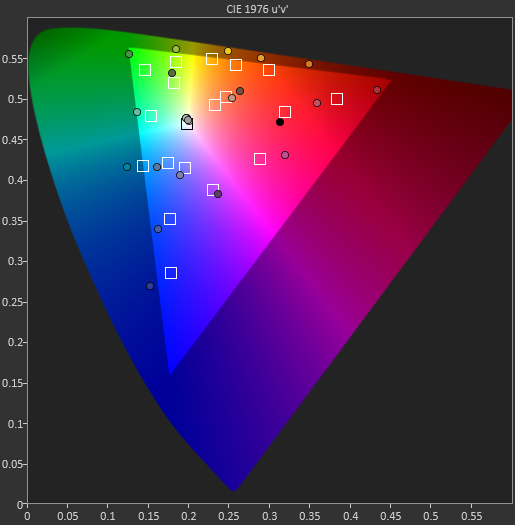








179 Comments
View All Comments
coder543 - Wednesday, September 17, 2014 - link
Nope.Flunk - Wednesday, September 17, 2014 - link
That's right, it's only been 39 nears since the "Metric Conversion Act" of 1975. Not 100 years.theuglyman0war - Thursday, September 18, 2014 - link
Not sure but wasn't the Metric Conversion Act a direct response to some initial action made by Woodrow Wilson? At least that is what I was taught in grade school in the 70's.What is really irksome is that despite there being a massive campaign by school systems to make the date where we were actually getting a handle on the metric conversion at the time...
Because all the "grown ups" at the time were waving their hands and running around like chickens yelling "it's useless!" "it's useless!" the whole program died an unfair death even though we were learning and understanding the world in metric just fine!
( now that I am 50 and forgot how to look at the world in units of 10 it is officially useless! )
keithzg - Monday, September 22, 2014 - link
Yeah, the resistance by "grown ups" to the Metric system was, and continues to be, pretty ridiculous. I mean, units of 10? However will I conceptualize that?!?! It's not like it equals the count of my fingers, or my numerical system is based on that or anything!melgross - Thursday, September 18, 2014 - link
Actually, it was back in 1866 that Congress passed a law requiring businesses and government to convert to metric as soon as possible, and to begin teaching it in schools. Unfortunately, no one paid attention.usernametaken76 - Wednesday, September 17, 2014 - link
What size screen does your phone have again?soccerballtux - Thursday, September 18, 2014 - link
ouchhhhhhh heheRatman6161 - Wednesday, September 17, 2014 - link
My fellow Americans: 1 inch = approximately 25mm. But really does it matter? The numbers are just so you can compare it to other phones so as long as all the reviews use a consistent unit of measure, why does it matter? Just saying. If it does matter to you, wip our your calculator.Arkive - Wednesday, September 17, 2014 - link
Wow. I was born and raised in America and even I am astonished by this comment. Seriously, we are not the only ones reading these articles, plus, metric is clearly better than our randomly generated units of measurement.Fergy - Wednesday, September 17, 2014 - link
If you give someones height as 5 feet 2 inch it is even worse.1 feet = 30.48cm, 1 inch = 2.54cm
5x30.48cm=152.4cm + 2x2.54cm=5.08cm
152.4cm+5.08cm=157.48cm
So that is 157.48cm or 1.5748m. I get that you grew up with the imperial system but the metric system is so much easier to use and it is the default for science.